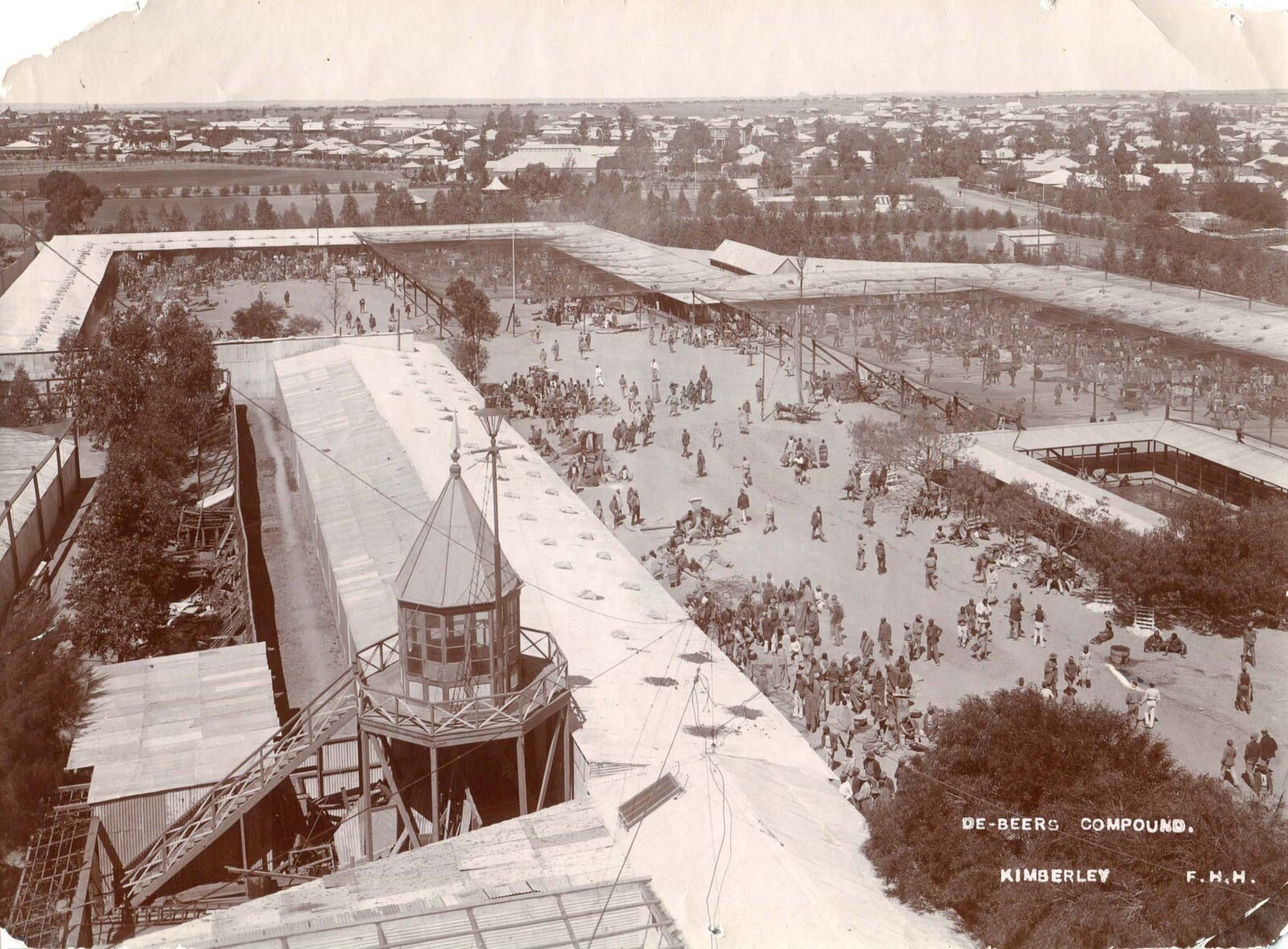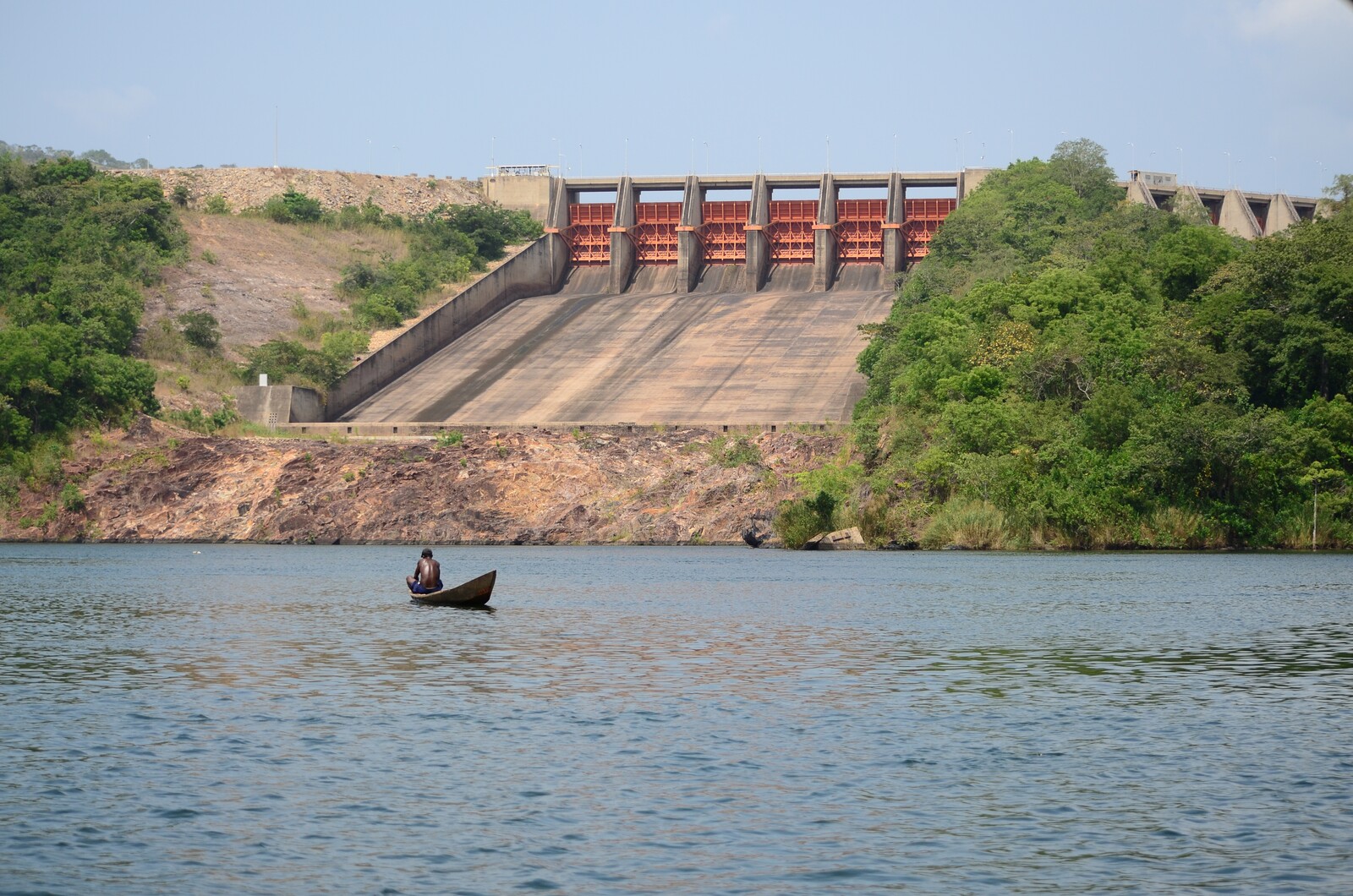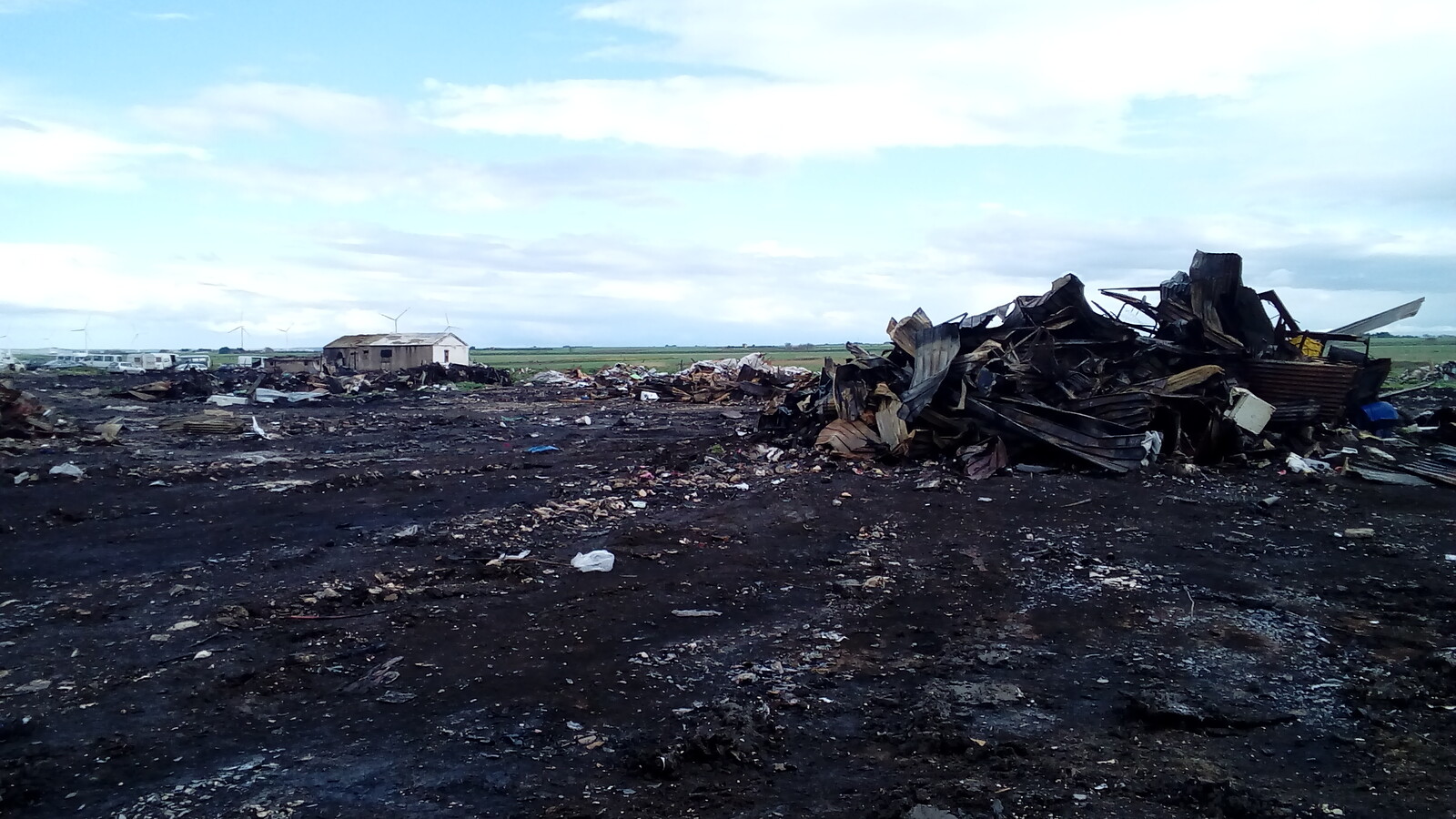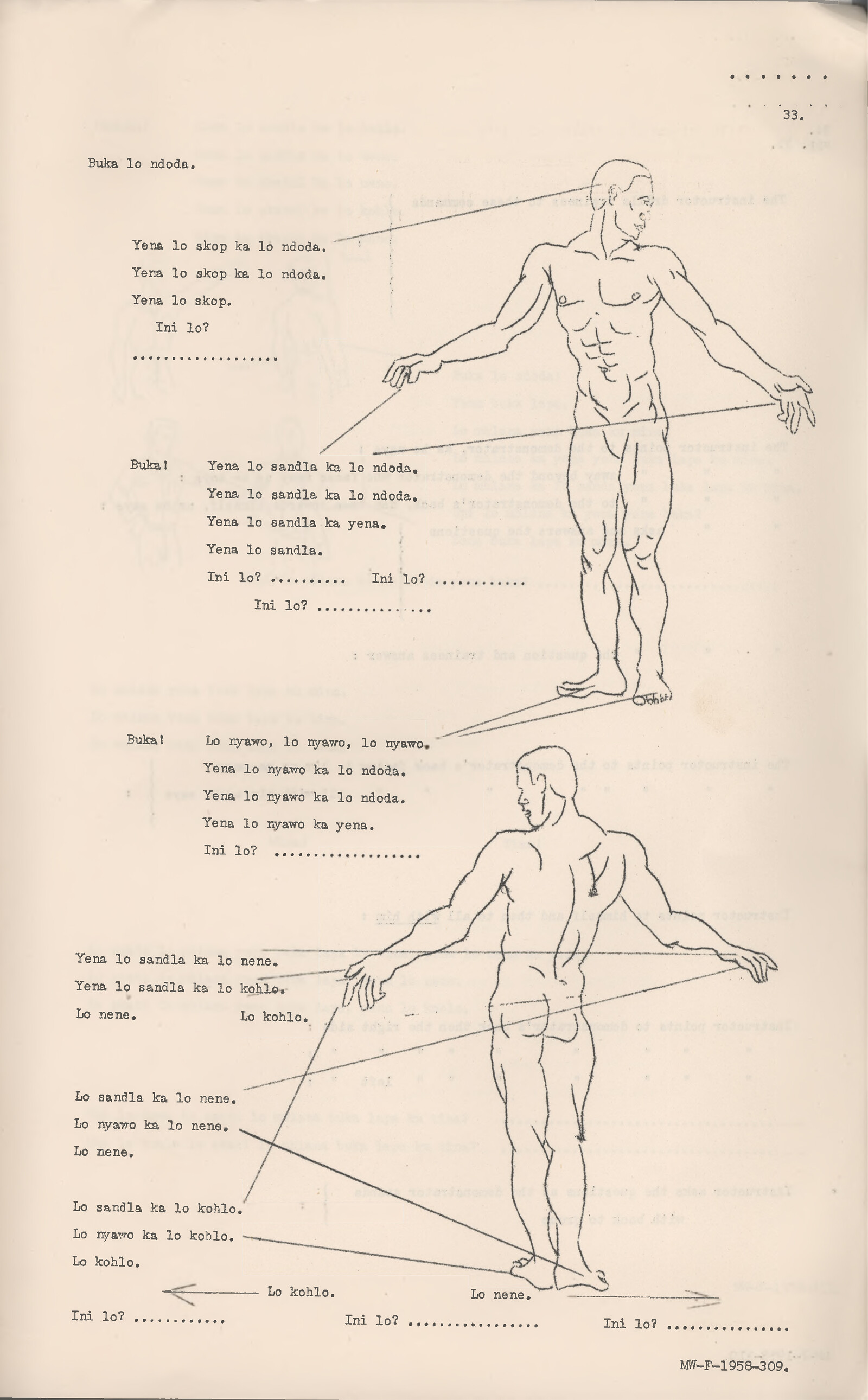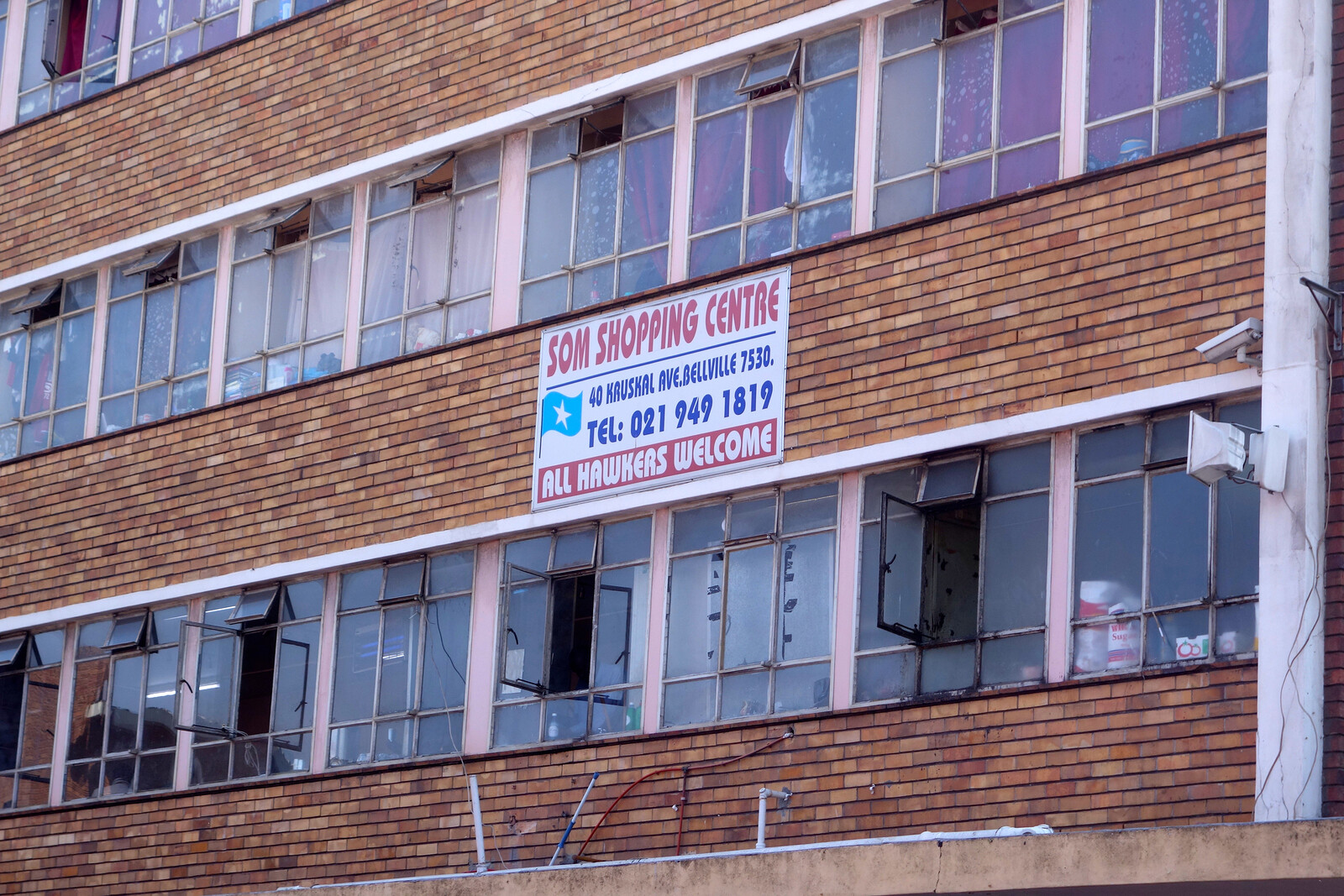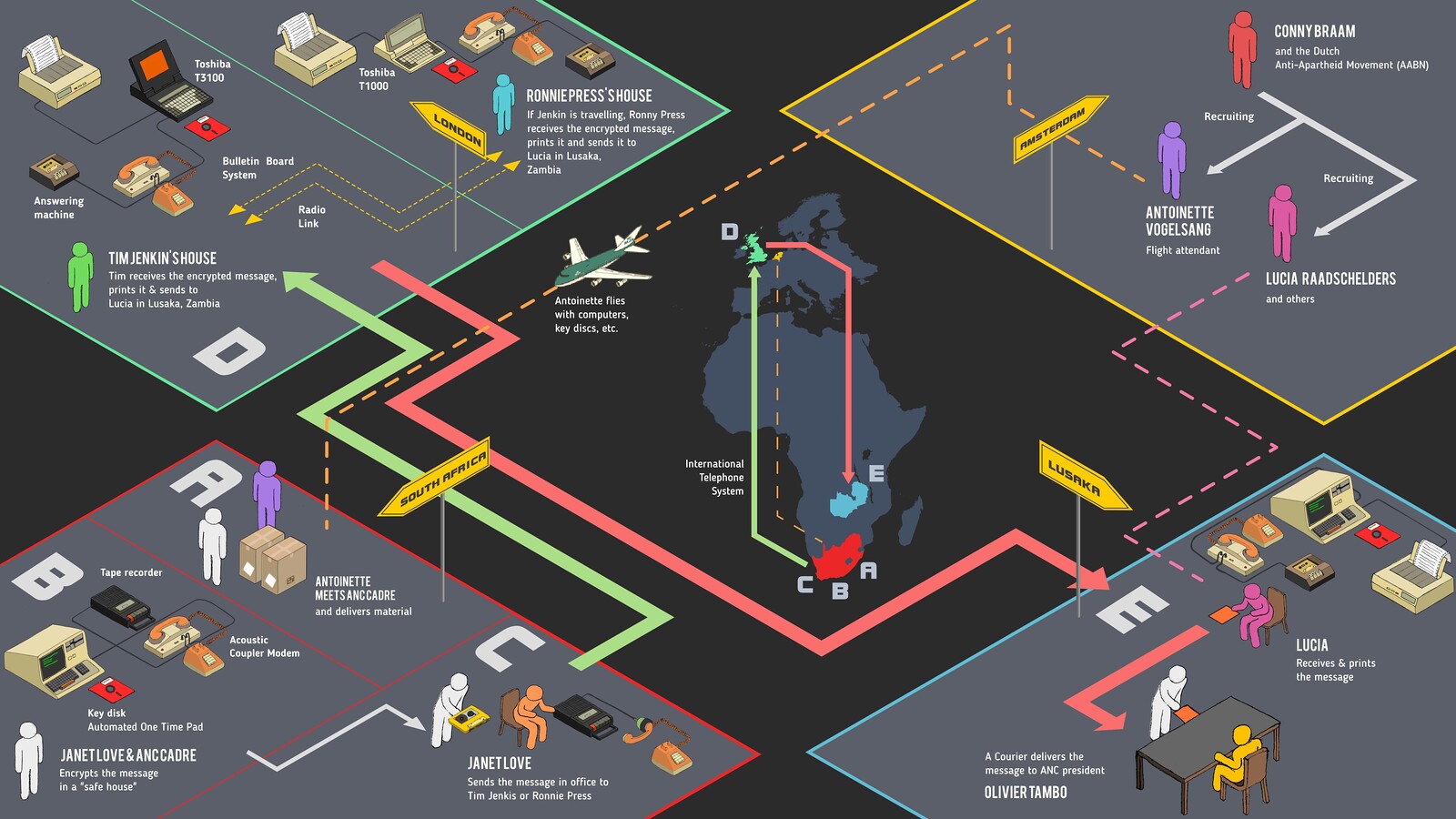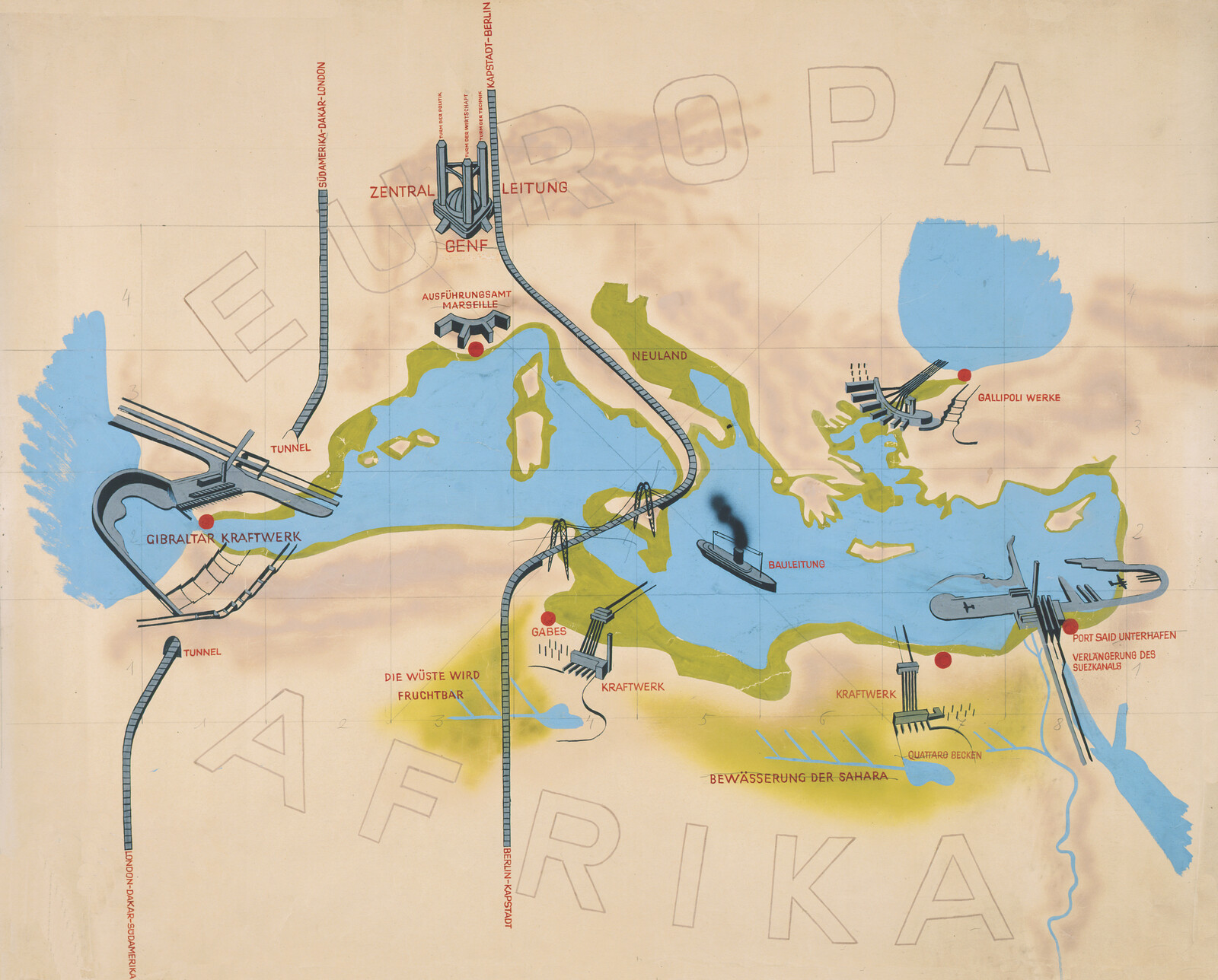In the mid-1880s, Kimberley’s diamond mines began constructing massive complexes to house their laborers.1 The closed compounds—so named because migrant laborers from across southern Africa were confined there for the duration of their contracts—were modeled after existing carceral, plantation, and industrial infrastructures. They were considered a major success in Kimberley, and quickly spread throughout southern Africa and the colonized world. The compounds were designed as classic panopticons, placing every inch of space between the high watchtower and the compound manager’s office under surveillance. The cramped living quarters were arranged side by side in a single row along the perimeter of the property, with communal areas at the center, including a basic goods store, bathing facilities, and a hospital. The boundaries of the compound were inviolable: workers traveled to the mine via underground tunnels or through walkways enclosed in wire mesh.
The mine operators envisioned the compounds as an infrastructural fix for a number of labor problems that they had been unable to resolve through the legal system, chiefly the risk of theft. The particular qualities of diamonds—small, lightweight, and therefore easy to transport on one’s person—meant that preventing theft required a level of surveillance and restriction far beyond what was standard in other nineteenth-century industries. After increasingly harsh legal restrictions on the movement and freedom of laborers proved ineffective in quelling the illicit trade, the mines pivoted towards a technical solution. This shift in orientation can be attributed, at least in part, to the elevation of engineers into senior management positions at the mines. Engineering only started being professionalized in this period, and managerial duties were increasingly included in the scope of an engineer’s role. This meant that those tasked with remedying the problem of theft had both the inclination and technical skills to develop an infrastructural solution.
While the compounds have attracted significant scholarly attention, they have almost universally been studied as manifestations of existing racist attitudes and policy.2 The compounds, however, were not merely imposed in an already racially-differentiated population. Rather, they were themselves productive of race. This is not to say that notions of race were not already circulating in Kimberley at that time, but rather that the compound played a significant role in consolidating the figure of “the Native.” In this sense, the nineteenth century southern Africa mining compound is an infrastructure that not only enabled the extraction of diamonds from the earth, but that did so by producing racialized bodies available for the neglect and violence necessary for such a process of extraction.
Race as Infrastructure
Contemporary commitments to anti-racism are rarely accompanied by equal interest in questions about the nature of race itself. In avoiding ontological questions about what kind of thing race is, we implicitly accept the nature of race as obvious and given in one of two ways: either as simply describing a natural fact of human difference, or as a social construct. While the latter conception can be incredibly useful as a negation of the former, it leaves many important questions unanswered. What kind of process is this social construction? What kind of thing is being constructed? Why is race so resilient even when acknowledged as human-made? And what does the body have to do with this construct of race?
The violence of race is not only epistemic, though it is undeniably so; this violence is also and primarily material. Racial violence is the violence of material neglect, precarity, and exposure to death.3 The violence of the Kimberley compounds was undeniably corporeal; it was the violence of bodies immobilized, neglected, and violated. Race in Kimberley functioned as a material rather than biological category, structuring the circulations of bodies and objects in space for the related ends of accumulation and population management. This violence, then, can be understood as a process of race-making, rather than a violation of an already and inherently racialized body. Race is not of the body, but it certainly happens to bodies.
When undertaking anti-racist work, we must consider actual material infrastructures—roads, railways, electricity networks, or, in this case, compounds—as ethnographic objects through which the production and management of race can be tracked. These objects mediate the relationship between bodies and their environments, and materialize racialized difference. But race itself can also be considered an infrastructure. Race materially enables extraction, accumulation, and the biopolitical management of population. Race mediates the circulation and mobility of bodies, actually determining the spaces in which they are located and the extent to which those are spaces of nurturing, vitality, and care, or spaces of risk, neglect, and degradation. Race is an infrastructure.
Municipal infrastructures that deliver water and electricity into our homes, or the vaccine infrastructures that will become a part of our pandemic reality, work at the level of population to mediate our bodies and their relationship to life and death. These relationships of vitality and proximity to death do not just correlate to race; they are race itself. Race functions as a matrix that determines the value of different bodies and the extent to which they can be exposed to death or made to live. From neglected water pipes to sophisticated supply chains, race is at the core of the circulation of bodies and objects. It is the master infrastructure that determines which bodies circulate where and how, and what kinds of mobilities and access are available to whom.
Just as contemporary communications and electricity infrastructures are so interdependent that they become almost indistinguishable, so too is race intertwined with the material infrastructures through which it is enabled. To the extent that diamond mining in Kimberley required complex infrastructures of extraction, transportation, and storage, it also required a complex infrastructure of bodily differentiation and circulation. Race was not a coincidental byproduct in the extraction of diamonds; it was an essential infrastructure for that process, one that differentiated and appropriately circulated bodies through space.
Engineering Kimberlite Pipes and Digestive Tracts
At the turn of the twentieth century, Kimberley was a global infrastructure hub—a position that is often narrated through colonial relations, such as the fact that Kimberley had street lights before London. While sophisticated transportation, communication, and extractive infrastructures are central to the city’s historical identity, the compound—Kimberley’s biggest contribution to southern Africa’s infrastructural landscape—is conspicuously absent.4 Pioneered in Kimberley, the compound first spread to the gold mines of Johannesburg, and then to mines and other industries across the continent and throughout the colonized world. Due to its success, the emergence of the compound has often been positioned as inevitable. But a whole host of factors needed to come together for this specific infrastructure to develop. The emergence of the compound was facilitated by two important factors: the establishment of engineering as a scientific discipline and managerial profession, and the specific properties of the diamond as a commodity.
The diamond rush in Kimberley took place at precisely the moment that engineering was being formalized as a profession that involved not only technical expertise but also administrative and managerial duty. Engineering programs were first established at various American and European universities only in the mid-nineteenth century. And from the very start, race was central to this emerging discipline. Many of its early graduates would go on to work at extractive sites across the colonized world. More fundamentally, however, their training manuals, engineering journals, and memoirs present numerous references to the experiences of engineers encountering and managing the various Natives of the world.5 The diamond and, later, gold mines of South Africa were a prestigious posting for these early engineers, and their history is defined by the imbrication of technical and racial expertise.
At the time, the Cape of Good Hope government commissioned expert after expert to advise on how best to address the numerous crises in the mines. In 1879, the Cornish mining engineer Thomas Kitto was commissioned by the colonial government to report on the major diamond mines of Griqualand West. Kitto famously suggested that the mines adopt a similar system to the one that had been used to manage enslaved laborers on the Brazilian diamond fields: closed compounding. Throughout his reports, Kitto presents technical efficiency and population management as effectively inseparable.
Kitto’s reports paint a picture of a poorly planned and poorly managed industry in need of overhaul. One of the main issues facing diggers was debris: piles and piles of Kimberlite, or what was informally termed “blue ground.” To quote Kitto:
At present the debris is tipped out in long narrow heaps that wind, snakelike, in and out amongst the dwelling houses and washing floors, and in many instances afford ample shelter for any thief who wishes to try an experiment at his neighbour’s expense. Kafirs and Kafir huts are mixed with Europeans and hundreds of heaps of debris conceal the most abominable filth at almost every turn. If fevers are not prevalent in a place of this kind it says a great deal in favour of the climate.6
In Kitto’s mind, debris posed not just a problem of unworkable claims, but also a social problem. For Kitto, the problem of accumulating blue ground was also the problem of the unchecked and hyper-mobile Native laborer—figured here as both potential thief and disease vector.
Kitto gives detailed technical advice to improve the management of underground mining, including blasting, hauling, and transporting blue ground. Then, he moves seamlessly into the question of managing the mobility of labor. Kitto’s vision of the Native body, as simply part of the broader natural landscape in need of taming, follows a common settler-colonial logic. But Kitto’s proposal for an infrastructural complex had not yet become a standard solution. Kitto suggests more than a carceral fix; he moves beyond the expertise of the sheriff, the hard hand of the law, and goes into the technical management of objects and materials in circulation.
The technical challenge that Kimberley’s engineers faced in relation to the management of labor turned on the relationship between the body and the diamond. The specific properties of the diamond made the challenge of labor mobility and surveillance technically unique. The diamond, an exceptional commodity, is the most compact form of value: small and lightweight. While other gems like emeralds and rubies must be extracted from a hard shell of quartz, diamonds are already discrete objects disguised only by their soft clay surrounds. Upon finding a diamond, the discoverer can pick it up by hand, without attracting much attention, and transport it with no resources other than their own body.
These properties of the stone meant that, in order to prevent theft, diamond mining required an unprecedented level of surveillance. The concern around the ease with which diamonds could be concealed by laborers was most fervently articulated in stories of laborers swallowing diamonds, which were frequently recounted in industry, government, and popular publications. The discourse around the thieving southern African Native was, however, different from the racist narratives that emerged in relation to Brazilian or Indian diamond fields. The extraordinary ability and willingness to conceal diamonds was put forward as a unique racial characteristic in southern Africa. 7
If the need to search the Native body was racially rationalized, the problem of actually searching is a very practical one. The total control promised by the compound therefore depended on a single key space embedded within: the searching house. Essentially a prison within the prison, the searching house was a space of intense surveillance and physical violation, a single room where workers would be detained for five to ten days at the end of their contracts. During this time they were kept completely naked, wearing only a pair of leather mittens, with a blanket for warmth. Departing men were made to eat from troughs on the floor and defecate over meshed pit latrines in order to totally control and surveil their digestive systems and enable the detection of any swallowed stones.
In the process of incarceration in the searching house, the meaning of the body of African migrant laborers was entirely rescripted. The compound enacted a total objectification, whereby the laborer’s body was scrutinized and turned over, in much the same way as the blue ground. Just as the mining engineer had to plan the transportation of precious soil from deep in the earth to the sorting floor, so too they planned the mobility of the laboring body, so that at no moment might a diamond fall through the cracks. The laborer’s body was reduced to an assemblage of orifices, crevices, tracts, and pipes. And, like the blue ground, it had to be searched and searched again, shuttled through space, under constant watch. The body was simply an object moving through a complex infrastructure of extraction.
The Endurance of Racialized Violence
If the figure of the Native laborer that emerges in Kimberley reflects the specific conditions of the diamond industry, it also evokes a foundational relation between race and infrastructure—a relation still seen in contemporary South Africa and many other sites of racial violence across the world.8 All racialized positions describe a relationship to infrastructure, to the extent that to be racialized is to be made vulnerable through infrastructural neglect or infrastructural coercion.
A striking example from contemporary South Africa is the prepaid meter, a technology that mediates access to water or electricity at the point of use. South Africa is a global innovator in point-of-use technologies and exports prepaid meters and other similar devices to countries across the African continent. The prepaid meter works by limiting the supply of electricity or water based on the input of tokens. Rather than being billed for prior usage, households must purchase and input tokens that then activate the supply of a corresponding amount of either water or electricity. Municipalities target “indigent households” for installation and often tie debt amnesties or the reconnection of services to the installation of a prepaid meter. This means that for hundreds of thousands of households without adequate income, electricity and water become scarce commodities rather than basic goods to which they are entitled.9
These technologies have faced incredible resistance in the communities on which they are imposed, and were one of the galvanizing issues for anti-neoliberal movements in the late 1990s and early 2000s. Not only is limiting access to water and electricity harmful in itself, but water and electricity shortages have had many serious secondary implications, including making people more vulnerable to fire and disease. While prepaid technologies were one of a number of neoliberal policies implemented in the post-apartheid era, they are also part of a lineage of infrastructural violence in South Africa. When considered alongside early infrastructures like mining compounds, the racializing capacities of these new technologies come into sharp focus. They not only work on already racialized populations, but they also re-materialize and reanimate the violent workings of race in South Africa.
The prepaid meter, like the compound, is an example of a single infrastructure with dual functions of infrastructural management and infrastructural neglect, both depriving the body and controlling its basic functions and mobilities. This duality is experienced and named by affected communities as racial violence, not only because it is repeatedly imposed on black communities, but also because it constantly re-sutures violence to black life.
Kimberley, now the capital of Northern Cape province in South Africa, was established in 1873 under the authority of the Cape Colony. The site, inhabited earlier by the local Griqua people, was previously named Vooruitzigt by the De Beer brothers, and later known colloquially as “New Rush” during the influx of prospectors after 1870.
Noteworthy early works on the Kimberley diamond fields include: Jonathan Crush, “Scripting the compound: power and space in the South African mining industry,” Environment and Planning D: Society and Space 12, no. 3 (1994): 301–324; Alan Mabin, “Labour, capital, class struggle and the origins of residential segregation in Kimberley, 1880–1920,” Journal of Historical Geography 12, no. 1 (1986): 4–26; Robert Vicat Turrell, Capital and Labour on the Kimberley Diamond Fields 1871–1890 (Cambridge: Cambridge University Press, 1987); William Hewlett Worger, “The making of a monopoly: Kimberley and the South African diamond industry, 1870–95” (PhD diss., Yale University, 1982).
Ruth Wilson Gilmore defines racism as “the state-sanctioned and/or extralegal production and exploitation of group-differentiated vulnerability to premature death.” Ruth Wilson Gilmore, Golden Gulag: Prisons, Surplus, Crisis, and Opposition in Globalizing California (Berkeley: University of California Press, 2007), 247. For more on the relationship between race and vulnerability to death, see the work of Saidiya Hartman, Achille Mbembe, and Christina Sharpe.
Kimberley’s tourism circuit includes trips along a portion of the city’s original tramline, a stop at the antique cast iron streetlights, a site marking the city’s pioneering role in South African aviation, and dozens of other examples of well-preserved infrastructure from the nineteenth century. The Big Hole Museum, Kimberley’s premier tourist attraction, funded by De Beers, describes its attractions as “period buildings that have been preserved or restored to their original glory; these include a church built in Europe and shipped to Kimberley, Barney Barnato’s boxing academy, the digger’s sleeping quarters and the De Beers railway coach, used by Cecil John Rhodes to commute between Cape Town and Kimberley.”
The Engineering and Mining Journal, considered the premier engineering journal of the nineteenth and early twentieth centuries, contains countless references to the management of native labor forces around the world. Take, for example, a set of four articles on the Kimberley diamond mines published in the journal between 1903 and 1905. The reports were written by Thomas Lane Carter, an American engineer trained at Tulane University, who was working in South Africa at the time. Carter’s writings include geological observations and notes on the innovation and sophistication of the De Beers mining techniques, alongside discussion of how De Beers managed the specific qualities of the southern African Native laborer. A second relevant example is the 1907 publication of a lecture delivered by J.H. Pitchford to engineering students at the University of California. The lecture includes mention of De Beers and the native laborers in its employ, whom he describes as “the happiest and most independent people in the world” due to the success of compounding.
Government Notice 1879: Report of T.C. Kitto, John Michael Smallberger Collection, Series B, Subseries B23 Government Publications, Folder 1, University of Cape Town Special Collections, Cape Town, South Africa.
Danielle C. Kinsey, “Imperial splendor: Diamonds, commodity chains, and consumer culture in nineteenth-century Britain” (PhD diss., University of Illinois at Urbana-Champaign, 2011).
Some of the most compelling work on infrastructural violence is on the occupation of Gaza; see, for example, Jasbir Puar, Francesco Sebregondi and Helga Tawil-Souri.
Antina Von Schnitzler, “Citizenship prepaid: Water, calculability, and techno-politics in South Africa,” Journal of Southern African Studies 34, no. 4 (2008): 899–917.
Coloniality of Infrastructure is a collaboration between e-flux Architecture, Critical Urbanisms at the University of Basel, and the African Centre for Cities of the University of Cape Town.

